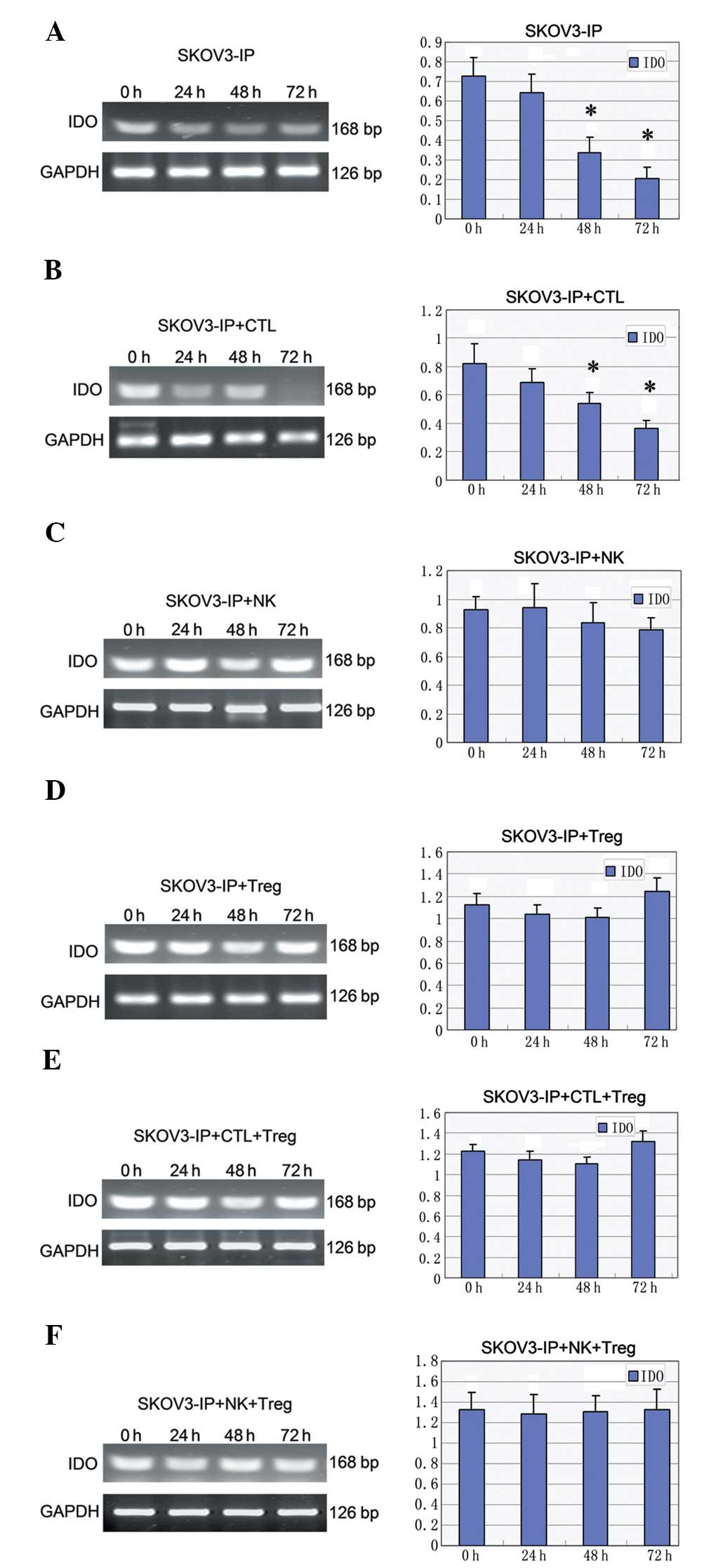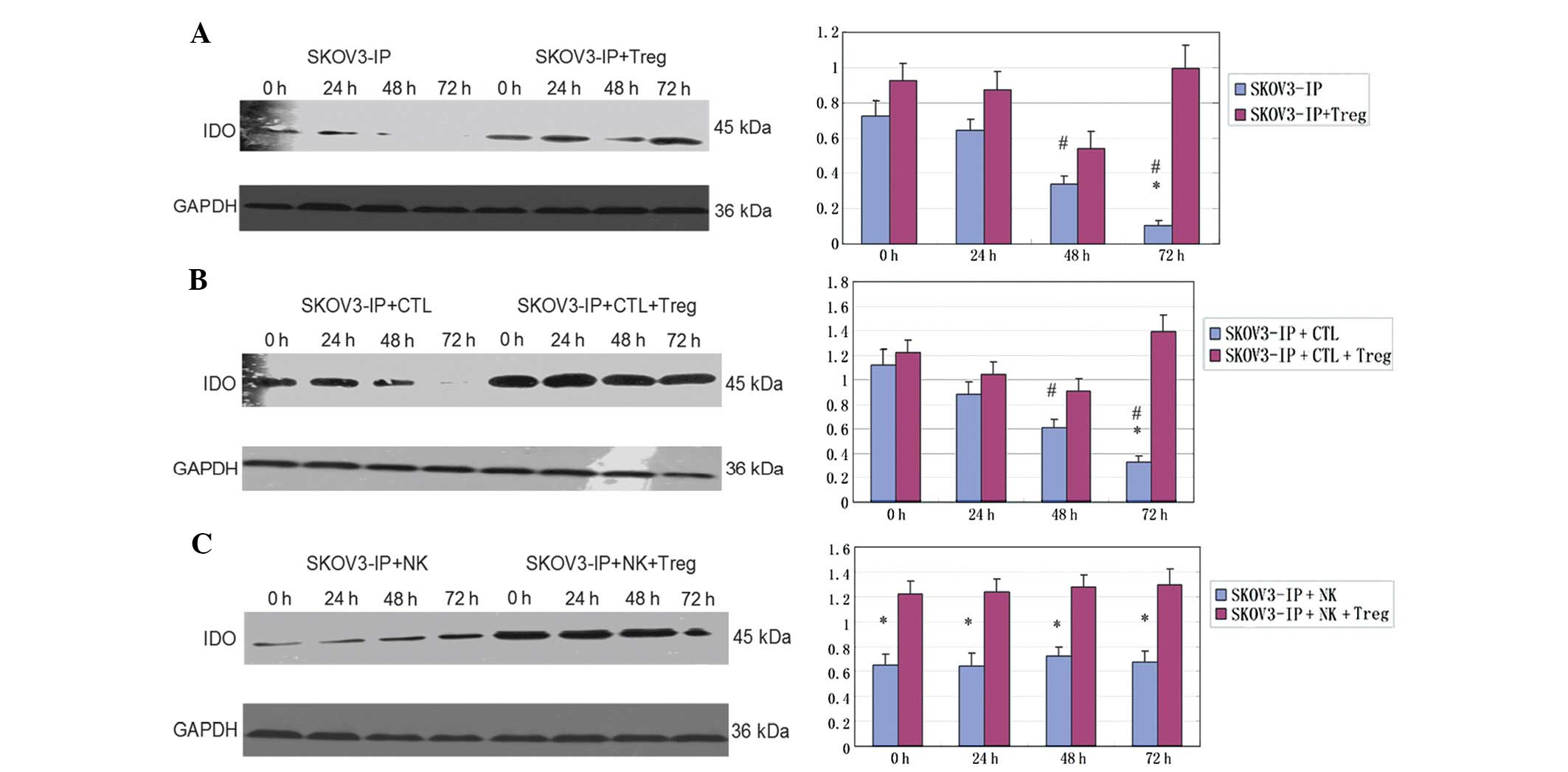|
1
|
Fehrmann RS, Li XY, van der Zee AG, et al:
Profiling studies in ovarian cancer: a review. Oncologist.
12:960–966. 2007. View Article : Google Scholar : PubMed/NCBI
|
|
2
|
Dougan M and Dranoff G: Immunotherapy of
cancer. Innate Immune Regulation and Cancer Immunotherapy. Wang RF:
Springer; New York: pp. 391–414. 2012, View Article : Google Scholar
|
|
3
|
Wållberg M, Wong FS and Green EA: An
islet-specific pulse of TGF-β abrogates CTL function and promotes β
cell survival independent of Foxp3+ T cells. J Immunol.
186:2543–2551. 2011. View Article : Google Scholar
|
|
4
|
Lu L, Zhou X, Wang J, Zheng SG and Horwitz
DA: Characterization of protective human
CD4+CD25+ FOXP3+ regulatory T
cells generated with IL-2, TGF-β and retinoic acid. PLoS One.
5:e151502010. View Article : Google Scholar
|
|
5
|
Teoh D and Secord AA: Antiangiogenic
agents in combination with chemotherapy for the treatment of
epithelial ovarian cancer. Int J Gynecol Cancer. 22:348–359. 2012.
View Article : Google Scholar : PubMed/NCBI
|
|
6
|
Stein P, Weber M, Prüfer S, et al:
Regulatory T cells and IL-10 independently counterregulate
cytotoxic T lymphocyte responses induced by transcutaneous
immunization. PLoS One. 6:e279112011. View Article : Google Scholar : PubMed/NCBI
|
|
7
|
Mei J, Li MQ, Ding D, et al: Indoleamine
2,3-dioxygenase-1 (IDO1) enhances survival and invasiveness of
endometrial stromal cells via the activation of JNK signaling
pathway. Int J Clin Exp Pathol. 6:431–444. 2013.PubMed/NCBI
|
|
8
|
Chen SS, Corteling R, Stevanato L and
Sinden J: Polyphenols inhibit indoleamine 3,5-dioxygenase-1
enzymatic activity - a role of immunomodulation in chemoprevention.
Discov Med. 14:327–333. 2012.PubMed/NCBI
|
|
9
|
Chen S, Corteling R, Stevanato L and
Sinden J: Natural inhibitors of indoleamine 3,5-dioxygenase induced
by interferon-γ in human neural stem cells. Biochem Biophys Res
Commun. 429:117–123. 2012. View Article : Google Scholar : PubMed/NCBI
|
|
10
|
Wang D, Saga Y, Mizukami H, et al:
Indoleamine-2,3-dioxygenase, an immunosuppressive enzyme that
inhibits natural killer cell function, as a useful target for
ovarian cancer therapy. Int J Oncol. 40:929–934. 2012.
|
|
11
|
de Jong RA, Nijman HW, Boezen HM, et al:
Serum tryptophan and kynurenine concentrations as parameters for
indoleamine 2,3-dioxygenase activity in patients with endometrial,
ovarian, and vulvar cancer. Int J Gynecol Cancer. 21:1320–1327.
2011.PubMed/NCBI
|
|
12
|
Opitz CA, Litzenburger UM, Opitz U, et al:
The indoleamine-2,3-dioxygenase (IDO) inhibitor
1-methyl-D-tryptophan upregulates IDO1 in human cancer cells. PLoS
One. 6:e198232011. View Article : Google Scholar : PubMed/NCBI
|
|
13
|
Fallarino F, Grohmann U, You S, et al: The
combined effects of tryptophan starvation and tryptophan
catabolites down-regulate T cell receptor ζ-chain and induce a
regulatory phenotype in naive T cells. J Immunol. 176:6752–6761.
2006. View Article : Google Scholar : PubMed/NCBI
|
|
14
|
Erkanli S, Bolat F, Kayaselcuk F, Demirhan
B and Kuscu E: COX-2 and survivin are overexpressed and positively
correlated in endometrial carcinoma. Gynecol Oncol. 104:320–325.
2007. View Article : Google Scholar
|
|
15
|
Schwandt A, Garcia JA, Elson P, et al:
Clinical and immunomodulatory effects of celecoxib plus
interferon-α in metastatic renal cell carcinoma patients with COX-2
tumor immunostaining. J Clin Immunol. 31:690–698. 2011. View Article : Google Scholar : PubMed/NCBI
|
|
16
|
Hryniewicz A, Boasso A, Edghill-Smith Y,
et al: CTLA-4 blockade decreases TGF-β, IDO, and viral RNA
expression in tissues of SIVmac251-infected macaques. Blood.
108:3834–3842. 2006. View Article : Google Scholar : PubMed/NCBI
|
|
17
|
Wolf AM, Wolf D, Steurer M, Gastl G,
Gunsilius E and Grubeck-Loebenstein B: Increase of regulatory T
cells in the peripheral blood of cancer patients. Clin Cancer Res.
9:606–612. 2003.PubMed/NCBI
|
|
18
|
Curiel TJ, Coukos G, Zou L, et al:
Specific recruitment of regulatory T cells in ovarian carcinoma
fosters immune privilege and predicts reduced survival. Nat Med.
10:942–949. 2004. View
Article : Google Scholar : PubMed/NCBI
|
|
19
|
Matsushita H, Morishita R, Nata T, et al:
Hypoxia-induced endothelial apoptosis through nuclear factor-κB
(NF-κB)-mediated bcl-2 suppression: in vivo evidence of the
importance of NF-κB in endothelial cell regulation. Circ Res.
86:974–981. 2000. View Article : Google Scholar : PubMed/NCBI
|
|
20
|
He X, Brenchley PE, Jayson GC, Hampson L,
Davies J and Hampson IN: Hypoxia increases heparanase-dependent
tumor cell invasion, which can be inhibited by antiheparanase
antibodies. Cancer Res. 64:3928–3933. 2004. View Article : Google Scholar : PubMed/NCBI
|
|
21
|
Munn DH and Mellor AL: Indoleamine
2,3-dioxygenase and tumor-induced tolerance. J Clin Invest.
117:1147–1154. 2007. View
Article : Google Scholar : PubMed/NCBI
|
|
22
|
Setoguchi R, Hori S, Takahashi T and
Sakaguchi S: Homeostatic maintenance of natural Foxp3+
CD25+ CD4+ regulatory T cells by interleukin
(IL)-2 and induction of autoimmune disease by IL-2 neutralization.
J Exp Med. 201:723–735. 2005. View Article : Google Scholar : PubMed/NCBI
|
|
23
|
Saraiva M and O’Garra A: The regulation of
IL-10 production by immune cells. Nat Rev Immunol. 10:170–181.
2010. View
Article : Google Scholar : PubMed/NCBI
|
|
24
|
Orlova VV, Liu Z, Goumans MJ and ten Dijke
P: Controlling angiogenesis by two unique TGF-β type I receptor
signaling pathways. Histol Histopathol. 26:1219–1230.
2011.PubMed/NCBI
|
|
25
|
Boniface K, Blumenschein WM, Brovont-Porth
K, et al: Human Th17 cells comprise heterogeneous subsets including
IFN-γ-producing cells with distinct properties from the Th1
lineage. J Immunol. 185:679–687. 2010. View Article : Google Scholar : PubMed/NCBI
|
|
26
|
Voskoboinik I, Dunstone MA, Baran K,
Whisstock JC and Trapani JA: Perforin: structure, function, and
role in human immunopathology. Immunol Rev. 235:35–54.
2010.PubMed/NCBI
|
|
27
|
Elpek KG, Lacelle C, Singh NP, Yolcu ES
and Shirwan H: CD4+CD25+ T regulatory cells
dominate multiple immune evasion mechanisms in early but not late
phases of tumor development in a B cell lymphoma model. J Immunol.
178:6840–6848. 2007. View Article : Google Scholar : PubMed/NCBI
|
|
28
|
Lee Y and Gustafsson AB: Role of apoptosis
in cardiovascular disease. Apoptosis. 14:536–548. 2009. View Article : Google Scholar : PubMed/NCBI
|
|
29
|
Facciabene A, Santoro S and Coukos G: Know
thy enemy: Why are tumor-infiltrating regulatory T cells so
deleterious? Oncoimmunology. 1:575–577. 2012. View Article : Google Scholar : PubMed/NCBI
|
|
30
|
Diao Z, Shi J, Zhu J, et al: TRAIL
suppresses tumor growth in mice by inducing tumor-infiltrating
CD4+CD25+ Treg apoptosis. Cancer Immunol
Immunother. 62:653–663. 2013. View Article : Google Scholar
|
|
31
|
Naora H and Montell DJ: Ovarian cancer
metastasis: integrating insights from disparate model organisms.
Nat Rev Cancer. 5:355–366. 2005. View
Article : Google Scholar : PubMed/NCBI
|
|
32
|
Tan DS, Agarwal R and Kaye SB: Mechanisms
of transcoelomic metastasis in ovarian cancer. Lancet Oncol.
7:925–934. 2006. View Article : Google Scholar : PubMed/NCBI
|
|
33
|
Facciabene A, Peng X, Hagemann IS, et al:
Tumour hypoxia promotes tolerance and angiogenesis via CCL28 and
T(reg) cells. Nature. 475:226–230. 2011. View Article : Google Scholar : PubMed/NCBI
|
|
34
|
Facciabene A, Motz GT and Coukos G:
T-regulatory cells: key players in tumor immune escape and
angiogenesis. Cancer Res. 72:2162–2171. 2012. View Article : Google Scholar : PubMed/NCBI
|














